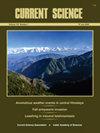城市、近郊和农村水体中SARS-CoV-2基因组片段的监测:时间和比较分析
IF 1
4区 综合性期刊
Q3 MULTIDISCIPLINARY SCIENCES
引用次数: 1
摘要
由于SARS-CoV-2大流行,与人为活动有关的水体可能会揭示病毒遗传物质的存在。在第一波和第二波COVID-19感染期间,对印度特伦甘纳邦海得拉巴及其周边的城市、城郊和农村水体进行了监测,以确定是否存在SARS-CoV-2基因片段。在城市周边和农村湖泊中未检测到SARS-CoV-2基因,而在具有家庭活动直接功能属性的城市湖泊中流行。在五个水体中观察到的病毒载量的明显变化与汇水区的人类活动一致。在第一波和第二波高峰期间观察到高病毒载量,特别是在城市湖泊。[源自作者]本文章由计算机程序翻译,如有差异,请以英文原文为准。
Surveillance of SARS-CoV-2 genome fragment in urban, peri-urban and rural water bodies: a temporal and comparative analysis
As a result of the SARS-CoV-2 pandemic, water bodies connected to anthropogenic activities may likely reveal the presence of viral genetic material. Urban, periurban and rural water bodies in and around Hyderabad, Telangana, India, were monitored for the presence of SARS-CoV-2 gene fragments during the first and second wave of COVID-19 infection. The SARS-CoV-2 genes were not detected in peri-urban and rural lakes, whereas urban lakes having direct functional attributes from domestic activity showed prevalence. Distinct variability in viral load observed among five water bodies was in concordance with human activity in the catchment area. High viral load was observed during the peaks of the first and second waves, specifically in urban lakes. [ FROM AUTHOR]
求助全文
通过发布文献求助,成功后即可免费获取论文全文。
去求助
来源期刊

Current Science
综合性期刊-综合性期刊
CiteScore
1.50
自引率
10.00%
发文量
97
审稿时长
3 months
期刊介绍:
Current Science, published every fortnight by the Association, in collaboration with the Indian Academy of Sciences, is the leading interdisciplinary science journal from India. It was started in 1932 by the then stalwarts of Indian science such as CV Raman, Birbal Sahni, Meghnad Saha, Martin Foster and S.S. Bhatnagar. In 2011, the journal completed one hundred volumes. The journal is intended as a medium for communication and discussion of important issues that concern science and scientific activities. Besides full length research articles and shorter research communications, the journal publishes review articles, scientific correspondence and commentaries, news and views, comments on recently published research papers, opinions on scientific activity, articles on universities, Indian laboratories and institutions, interviews with scientists, personal information, book reviews, etc. It is also a forum to discuss issues and problems faced by science and scientists and an effective medium of interaction among scientists in the country and abroad. Current Science is read by a large community of scientists and the circulation has been continuously going up.
Current Science publishes special sections on diverse and topical themes of interest and this has served as a platform for the scientific fraternity to get their work acknowledged and highlighted. Some of the special sections that have been well received in the recent past include remote sensing, waves and symmetry, seismology in India, nanomaterials, AIDS, Alzheimer''s disease, molecular biology of ageing, cancer, cardiovascular diseases, Indian monsoon, water, transport, and mountain weather forecasting in India, to name a few. Contributions to these special issues ‘which receive widespread attention’ are from leading scientists in India and abroad.
 求助内容:
求助内容: 应助结果提醒方式:
应助结果提醒方式:


